
Secotioid fungi are an intermediate growth form between mushroom-like hymenomycetes and closed bag-shaped gasteromycetes, where an evolutionary process of gasteromycetation has started but not run to completion. Secotioid fungi may or may not have opening caps, but in any case they often lack the vertical geotropic orientation of the hymenophore needed to allow the spores to be dispersed by wind, and the basidiospores are not forcibly discharged or otherwise prevented from being dispersed —note—some mycologists do not consider a species to be secotioid unless it has lost ballistospory.

The genus Amanita contains about 600 species of agarics, including some of the most toxic known mushrooms found worldwide, as well as some well-regarded edible species. The genus is responsible for approximately 95% of fatalities resulting from mushroom poisoning, with the death cap accounting for about 50% on its own. The most potent toxin present in these mushrooms is α-Amanitin.
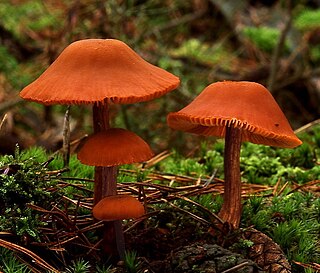
Laccaria laccata, commonly known as the deceiver, lackluster laccaria, or waxy laccaria, is a white-spored species of small edible mushroom found throughout North America and Europe. It is a highly variable mushroom, and can look quite washed out, colorless and drab, but when younger it often assumes red, pinkish brown, and orange tones. The species is often considered by mushroom collectors to be a 'mushroom weed' because of its abundance and plain stature.
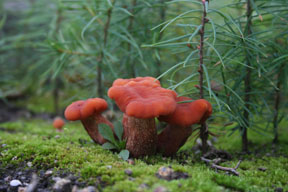
Laccaria bicolor is a small tan-colored mushroom with lilac gills. It is edible but not choice, and grows in mixed birch and pine woods. It is found in the temperate zones of the globe, in late summer and autumn. L. bicolor is an ectomycorrhizal fungus used as a soil inoculant in agriculture and horticulture.

Collybia nuda, commonly known as the blewit or wood blewit and previously described as Lepista nuda and Clitocybe nuda, is an edible mushroom native to Europe and North America. Described by Pierre Bulliard in 1790, it was also known as Tricholoma nudum for many years. It is found in both coniferous and deciduous woodlands. It is a fairly distinctive mushroom that is widely eaten. It has been cultivated in Britain, the Netherlands and France. This species was reassigned to the genus Collybia in 2023.
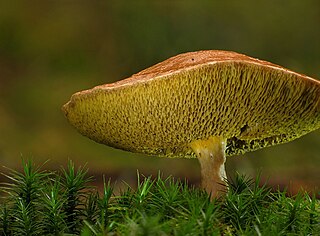
Suillus bovinus, also known as the Jersey cow mushroom or bovine bolete, is a pored mushroom of the genus Suillus in the family Suillaceae. A common fungus native to Europe and Asia, it has been introduced to North America and Australia. It was initially described as Boletus bovinus by Carl Linnaeus in 1753, and given its current binomial name by Henri François Anne de Roussel in 1806. It is an edible mushroom, though not highly regarded.

The European white egg, bearded amanita or European egg amidella, is a species of fungus of the genus Amanita in the family Amanitaceae. It is a large, white-colored fungus, often tinged with cream. Native to Europe, it is found on plains as well as mountains in the Mediterranean region. It is similar to some deadly poisonous species.

Laccaria is a genus around 75 species of fungus found in both temperate and tropical regions of the world. They are mycorrhizal. The type species is Laccaria laccata, commonly known as the deceiver. Other notable species include L. bicolor, and the amethyst deceiver (L. amethystina), sometimes incorrectly written as L. amethystea. Because some Laccaria species have the ability to grow vegetatively and/or germinate from basidiospores in culture, they are often used as experimental systems for studies of ectomycorrhizal basidiomycetes. They have a tetrapolar mating system, meaning that there the mating type is controlled by 2 loci. Recently, the genome of L. bicolor has been sequenced.
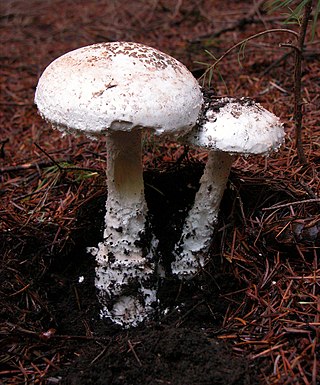
Amanita smithiana, also known as Smith's amanita, is a species of agaric found on soil in coniferous and broadleaved woodland in the Pacific Northwest of North America. It fruits in August and September.
Deceiver, Deceivers, The Deceiver or The Deceivers may refer to:

Inocybe geophylla, commonly known as the earthy inocybe, common white inocybe or white fibercap, is a poisonous mushroom of the genus Inocybe. It is widespread and common in Europe and North America, appearing under both conifer and deciduous trees in summer and autumn. The fruiting body is a small all-white or cream mushroom with a fibrous silky umbonate cap and adnexed gills. An all-lilac variety lilacina is also common.
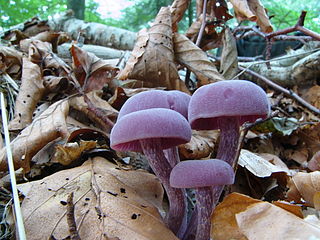
The Hydnangiaceae are a family of fungi in the mushroom order Agaricales. Widespread in temperate and tropical regions throughout the world, the family contains about 30 species in four genera. Species in the Hydnangiaceae form ectomycorrhizal relationships with various species of trees in both coniferous and deciduous forests.

Laccaria amethystina, commonly known as the amethyst deceiver, or amethyst laccaria, is a small brightly colored mushroom, that grows in deciduous and coniferous forests. The mushroom itself is edible, but can absorb arsenic from the soil. Because its bright amethyst coloration fades with age and weathering, it becomes difficult to identify, hence the common name "deceiver". This common name is shared with its close relation Laccaria laccata that also fades and weathers. It is found mainly in Northern temperate zones, though it is reported to occur in tropical Central and South America as well. Recently, some of the other species in the genus have been given the common name of "deceiver".
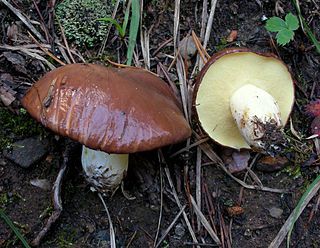
Suillus brevipes is a species of fungus in the family Suillaceae. First described by American mycologists in the late 19th century, it is commonly known as the stubby-stalk or the short-stemmed slippery Jack. The fruit bodies (mushrooms) produced by the fungus are characterized by a chocolate to reddish-brown cap covered with a sticky layer of slime, and a short whitish stipe that has neither a partial veil nor prominent, colored glandular dots. The cap can reach a diameter of about 10 cm, while the stipe is up to 6 cm long and 2 cm thick. Like other bolete mushrooms, S. brevipes produces spores in a vertically arranged layer of spongy tubes with openings that form a layer of small yellowish pores on the underside of the cap.
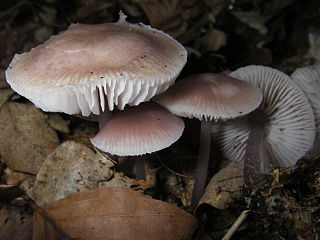
Mycena pura, commonly known as the lilac mycena, lilac bonnet, is a species of mushroom in the family Mycenaceae. First called Agaricus prunus in 1794 by Christian Hendrik Persoon, it was assigned its current name in 1871 by German Paul Kummer. Mycena pura is known to bioaccumulate the element boron.

Laccaria amethysteo-occidentalis is a mushroom found under conifers, usually pine, growing alone, scattered or gregariously in western North America.

Amanita pseudoporphyria, also known as Hongo's false death cap, is a species of agaric fungus from the genus Amanita.

Russula densifolia, commonly known as the crowded russula or the reddening russula, is a species of agaric fungus in the family Russulaceae. It was first described in 1833 and given its current name in 1876. A widespread species, it is found in Asia, Europe, and North America, where it fruits on the ground in mixed and deciduous forests. Fruit bodies (mushrooms) are robust and squat, with caps up to 14.5 cm (5.7 in) in diameter, and stems that are 2–7.5 cm (0.8–3.0 in) long by 1.2–2.5 cm (0.5–1.0 in) thick. The mushrooms are characterized by the red and then black color changes that occur in the flesh when it is bruised, and a relatively thick cap cuticle. Although the mushroom is sold as an edible species in some areas of Asia, it is mild to moderately toxic, and may cause gastrointestinal upset if consumed. Several bioactive compounds have been isolated and identified from the mushroom.
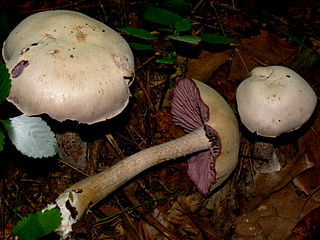
Laccaria ochropurpurea is an edible mushroom found under hardwood and conifers east of the Rocky Mountains. The pileus ranges from 4–13 centimetres wide and the stipe from 5–19 centimetres long.


















